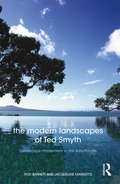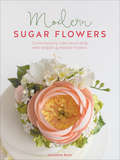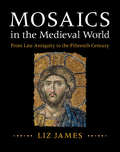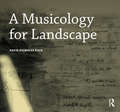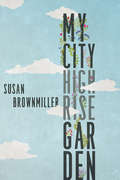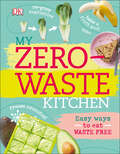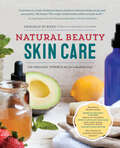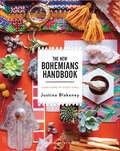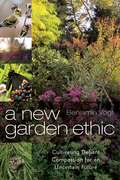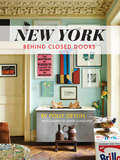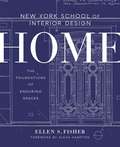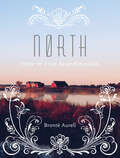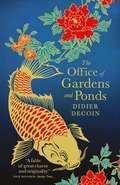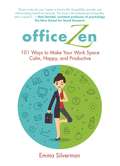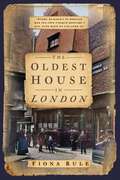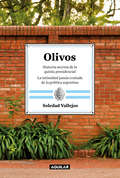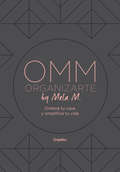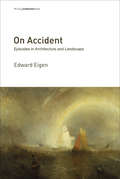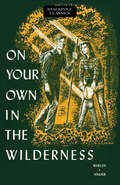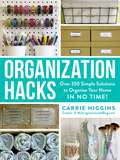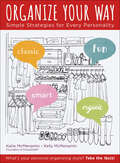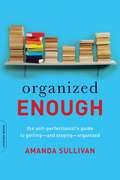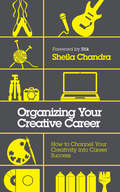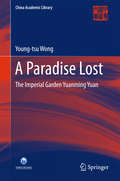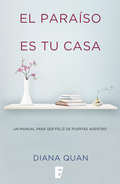- Table View
- List View
The Modern Landscapes of Ted Smyth: Landscape Modernism in the Asia-Pacific
by Jacqueline Margetts Rod BarnettThe modern period in landscape architecture is enjoying the fascinated appreciation of scholars and historians in Europe and the Americas, and new themes, new subjects and new appraisals are appearing. This book contributes to the conversation by focusing on the work of a singular designer who spent his entire career in a province of the North Island of New Zealand. Ted Smyth practiced an assured landscape modernism without ever seeing the designs of his forebears or his contemporaries working in the UK, Europe and the United States. Designing in isolation from the mainstream of modernism, and a little after its high tide, Smyth produced a series of gardens that provoke a revaluation of the diffusionist model of influence. The book explains and describes the evolution of Smyth’s design vocabulary and relates it to the development of tropical landscape modernism in other Asia-Pacific sites. It shows how a culture of garden modernism can be generated from within a particular locale, and highlights Smyth’s engagement with M?ori design traditions in search of a specific expression of the high modern essentialism of place.
Modern Sugar Flowers: Contemporary Cake Decorating with Elegant Gumpaste Flowers (Modern Sugar Flowers #1)
by Jacqueline ButlerThe most contemporary book on sugar flowers ever produced, which will remain a cornerstone reference title long into the future. Jacqueline Butler has an international following of over 270,000 engaged fans--her work is of the highest quality and the most desirable style.
Mosaics in the Medieval World: From Late Antiquity to the Fifteenth Century
by Liz JamesIn this book, Liz James offers a comprehensive history of wall mosaics produced in the European and Islamic middle ages. Taking into account a wide range of issues, including style and iconography, technique and material, and function and patronage, she examines mosaics within their historical context. She asks why the mosaic was such a popular medium and considers how mosaics work as historical 'documents' that tell us about attitudes and beliefs in the medieval world. The book is divided into two part. Part I explores the technical aspects of mosaics, including glass production, labour and materials, and costs. In Part II, James provides a chronological history of mosaics, charting the low and high points of mosaic art up until its abrupt end in the late middle ages. Written in a clear and engaging style, her book will serve as an essential resource for scholars and students of medieval mosaics.
A Musicology for Landscape (Design Research in Architecture)
by David Nicholas BuckDrawing conceptually and directly on music notation, this book investigates landscape architecture’s inherent temporality. It argues that the rich history of notating time in music provides a critical model for this under-researched and under-theorised aspect of landscape architecture, while also ennobling sound in the sensory appreciation of landscape. A Musicology for Landscape makes available to a wider landscape architecture and urban design audience the works of three influential composers – Morton Feldman, György Ligeti and Michael Finnissy – presenting a critical evaluation of their work within music, as well as a means in which it might be used in design research. Each of the musical scores is juxtaposed with design representations by Kevin Appleyard, Bernard Tschumi and William Kent, before the author examines four landscape spaces through the development of new landscape architectural notations. In doing so, this work offers valuable insights into the methods used by landscape architects for the benefit of musicians, and by bringing together musical composition and landscape architecture through notation, it affords a focused and sensitive exploration of temporality and sound in both fields.
My City Highrise Garden
by Susan BrownmillerGardening on rooftops, balconies, and terraces is a popular trend. After thirty-five years of experience, Susan Brownmiller writes with honesty and humor about her oasis twenty floors above a Manhattan street. She reports the catastrophes: losing daytime access during building-wide renovations; assaults from a mockingbird during his mating season. And the joys: a peach tree fruited for fifteen years; the windswept birches lasted for twenty-five. Butterflies and bees pay annual visits. She pampers a buddleia, a honeysuckle, roses, hydrangeas, and more. Her adventures celebrate the tenacity of nature, inviting readers to marvel at her garden’s resilience, and her own. Enhanced by over thirty color photographs, this passionate account of green life in a gritty, urban environment will appeal to readers and gardeners wherever they dwell.
My Zero-Waste Kitchen: Easy Ways to Eat Waste Free
by Kate TurnerLearn how to reduce food waste with quick tips and simple solutions in My Zero-waste Kitchen.Live sustainably and embrace the three R's: reduce, reuse, and recycle. In My Zero-waste Kitchen, find creative and unexpected ways to eliminate trash, save money, and give leftovers a new life. Plus, learn how to grow your own vegetables and herbs from scraps, and how to nourish your plants with compost.With 15 nutritious and versatile recipes in which nothing goes to waste, this guide shares the secrets to smart shopping, meal planning, and the nutritional value of often-discarded food products. Turn beetroot peelings into delicious falafel, pesto, or a melt-in-your-mouth cake. Revive produce nearing the end of its shelf life with "flexi" recipes—for risotto, stir-fry, smoothies, and more.The tips and tricks in My Zero-waste Kitchen show how easy it is to live more sustainably without making a complete lifestyle change.
Natural Beauty Skin Care: 110 Organic Formulas for a Radiant You!
by Deborah Burnes"In Natural Beauty Skin Care, you'll learn how to create wholesome beauty products without looking too far past your pantry. The bonus? The recipes and formulas within actually work."—DR. FRANK LIPMAN, founder of the Eleven-Eleven Wellness Center and New York Times bestselling author of The New Health Rules When it comes to skin care, everyone knows that natural is best, but with chemical-ridden products being mislabeled as "all-natural" and so many homemade beauty regimens available online, keeping it natural can feel complicated. Whether you're a homemade product junkie looking for affordable options, or just joining the natural skin care revolution— Natural Beauty Skin Care will get you and your skin back-to-basics—one natural product at a time. Skin care expert and co-founder of Sumbody Skin Care, Deborah Burnes, applies her specialized combination of chemistry, cosmetology, and natural medicine to create the eco-friendly skin care recipes in Natural Beauty Skin Care. This book is your guide to creating all-natural skin care products that achieve glowing, radiant skin, hair and nails. The simple, budget-friendly skin care recipes found in Natural Beauty Skin Carewill transform your skin and include decadent homemade beauty treats like Honey & Chia Seed Cleanser, Coconut Body Butter, and Argan Oil Shampoo. Natural, easy-to-make beauty recipes that eliminate chemicals from your skin care routine Head-to-toe indulgence cares for all the skin that you're in with nourishing body butters, hydrating hair masks, decadent bath bombs, and more Natural Ingredient 101—learn the eye-opening why's behind the step-by-step how's and go all-natural with your skin care for good
The New Bohemians Handbook: Come Home to Good Vibes
by Justina Blakeney“Justina’s style is so warm and colorful . . . All her plants and pallets and prints are put together in ways that are beyond stylish. It is art.” —Drew BarrymoreThe New Bohemian Handbook guides readers in beautifully simple techniques for adding good vibes and style to living spaces. Packed with hundreds of ideas for bringing positive energy to your home, the book features exercises and activities for thinking about rooms in new ways. With Justina Blakeney’s expert guidance, learn how to rearrange, paint, prop, and plant your way to a home that’s fresh and inspiring. Uncover your “spirit environment” and learn how to use color and scent to enhance mood, productivity, and relaxation. Revel in Justina’s encouraging advice (“you got this!”), and easily and affordably turn any dwelling into a personal sanctuary.“An indispensable manual to living in a home that’s pretty, restful, groovy and 100% you. This is my spirit book! Finally a book that offers specific, helpful ways to make a home feel original, beautiful and, most importantly, like a haven for its homeowner.” —Sophie Donelson, Editor in Chief, House Beautiful“With Ms. Blakeney as guide, princes, plumbers and poets alike can readily replicate the charm and ease of these featured interiors—from tiny urban studios to suburban domiciles to rustic retreats.” —The Wall Street Journal“As vibrant, rule-breaking and out the box as she showed in her first book . . . It’s part book, part yoga lesson as Blakeney walks readers through finding clarity, flow, growth and harmony in our homes.” —The Detroit News“Full of ideas for bringing positive energy to your home.” —The Washington Post
A New Garden Ethic: Cultivating Defiant Compassion for an Uncertain Future
by Benjamin VogtIn a time of climate change and mass extinction, how we garden matters more than ever: “An outstanding and deeply passionate book.” —Marc Bekoff, author of The Emotional Lives of AnimalsPlenty of books tell home gardeners and professional landscape designers how to garden sustainably, what plants to use, and what resources to explore. Yet few examine why our urban wildlife gardens matter so much—not just for ourselves, but for the larger human and animal communities.Our landscapes push aside wildlife and in turn diminish our genetically programmed love for wildness. How can we get ourselves back into balance through gardens, to speak life's language and learn from other species?Benjamin Vogt addresses why we need a new garden ethic, and why we urgently need wildness in our daily lives—lives sequestered in buildings surrounded by monocultures of lawn and concrete that significantly harm our physical and mental health. He examines the psychological issues around climate change and mass extinction as a way to understand how we are short-circuiting our response to global crises, especially by not growing native plants in our gardens. Simply put, environmentalism is not political; it's social justice for all species marginalized today and for those facing extinction tomorrow. By thinking deeply and honestly about our built landscapes, we can create a compassionate activism that connects us more profoundly to nature and to one another.
New York Behind Closed Doors
by Polly DevlinA look inside the homes of New York City&’s artists, designers, writers, and social influencers, including in-depth interviews. These twenty-four homes reflect the tastes and styles of real New Yorkers who live in small spaces with art, books, collections, treasures, and fabulous, sometimes funky furniture—each space expressing the resident&’s unique personality. Bright, captivating photographs throughout pair dynamically with Polly Devlin&’s in-depth interviews with the homeowners. Her critiques of their spaces are at once delightful, bold, and irreverent—and always lively and opinionated. From architectural grandeur to streamlined modern buildings, see how individuals turn older apartments and historic structures into places for comfortable living. Houses and apartments are sampled from across the city, including Tribeca, Murray Hill, Union Square, Harlem, Midtown, Brooklyn, and more. Assembled by a former Vogue editor and a photographer who has worked for House Beautiful, Travel + Leisure, and other major publications, this is a visual and literary feast. &“Showcases some of New York City&’s most unique residential dwellings.&”—Elle Decor
New York School of Interior Design: The Foundations of Enduring Spaces
by Ellen S. Fisher Alexa Hampton Jen RenziFrom the nation's top college for interior design comes a definitive design school in a book and a fabulous reference for decorating the home. In the past decade, New York School of Interior Design, which was founded in 1916, has drawn a large crossover audience of passionate decorating enthusiasts and hobbyists--many of them private homeowners who know that thinking like a professional is the surest way to achieve a magnificent home. This lavishly illustrated and highly detailed interior design bible provides a comprehensive education on home design and decor, from color theory principles to space-specific considerations (choosing furniture for a living room) and collaborating with architects and other professionals for the best results. Built on the Home Study Course that is the foundation of the school's curriculum, this book offers an unparalleled mastery of the key elements of enduring design, rendering it the only book you'll ever need.From the Hardcover edition.
North: How to Live Scandinavian (How To Live... Ser.)
by Brontë AurellA complete guide to Scandinavia filled with travel tips, cultural and historical facts, recipes, and inspirational photography from the Nordic nations.Why are Scandinavians constantly topping the happiness table? How do you get more Scandi-style in your life? Just how do you use lagom? Whether you want your apartment to look like it belongs in Copenhagen, to workout like a Norwegian or to make cinnamon buns like a Swede, this is the ultimate insider’s guide to the countries of the north.Full of inspiration and ideas, how-tos and recipes to help you experience the very best of Scandinavian design, philosophy, cookery, and culture, this honest behind-the-scenes look at the culture provides an invaluable insight into the wonderful and visually stunning world of Scandinavia. Like her viking ancestors before her, Brontë Aurell left Denmark to explore the world beyond home shores and in her travels has come to understand the fascination with her kinfolk, as well as seeing the idiosyncrasies of the Scandinavian lifestyle that locals take for granted.With a signature wit and a keen eye for detail, she takes you on a journey through fjords and mountains, farmlands, and cities to better understand these three nations and what makes each one so unique. So get outdoors, learn the life lesson that there’s no such thing as bad weather (only bad clothing), and you may discover your inner Scandi sooner than you think . . . From the How To Live . . . series of insightful guides to some of the most intriguing cultures and locations on the planet, other books available include How To Live Japanese, How To Live Korean, and How to Live Icelandic.
The Office of Gardens and Ponds
by Didier DecoinA mesmerising fable with a difference, set in Japan over 1000 years agoFor readers of Alessandro Baricco's Silk, Patrick Süskind's Perfume and Takashi Hiraide's The Guest Cat.The village of Shimae is thrown into turmoil when master carp-catcher Katsuro suddenly drowns in the murky waters of the Kusagawa river. Who now will carry the precious cargo of carp to the Imperial Palace and preserve the crucial patronage that everyone in the village depends upon?Step forward Miyuki, Katsuro's grief-struck widow and the only remaining person in the village who knows anything about carp. She alone can undertake the long, perilous journey to the Imperial Palace, balancing the heavy baskets of fish on a pole across her shoulders, and ensure her village's future.So Miyuki sets off. Along her way she will encounter a host of remarkable characters, from prostitutes and innkeepers, to warlords and priests with evil in mind. She will endure ambushes and disaster, for the villagers are not the only people fixated on the fate of the eight magnificent carp. But when she reaches the Office of Gardens and Ponds, Miyuki discovers that the trials of her journey are far from over. For in the Imperial City, nothing is quite as it seems, and beneath a veneer of refinement and ritual, there is an impenetrable barrier of politics and snobbery that Miyuki must overcome if she is to return to Shimae.
Office Zen: 101 Ways to Make Your Work Space Calm, Happy, and Productive
by Emma SilvermanYou do not need to climb to the top of the coldest, highest mountain to be Zen. You do not need to crawl on your hands and knees, seal yourself away in a cave, or stop eating birthday cake. Most importantly, at least for this book, you do not have to quit your job to be Zen. In Office Zen, you will learn how Zen can exist in any moment and any place, even the most stressful and high-strung office.Office Zen will be the first book to incorporate the Zen principles of mindfulness and simplicity into the home office and work station byproviding tips on how to remove clutter from your work spaceteaching meditation and stretching exercises to destress in two minutes or lesslaying the frame work for a healthy work-life balanceZen, and other mindfulness practices like it, asks us to examine the world around us with an emphasis on kindness and compassion toward ourselves and others. By being more meditative and calm in your daily interactions, you can bring peace into your workplace and happiness into your life.
The Oldest House in London
by Fiona RuleLondon's old buildings hold a wealth of clues to the city’s rich and vibrant past. The histories of some, such as the Tower of London and Westminster Abbey, are well documented. However, these magnificent, world-renowned attractions are not the only places with fascinating tales to tell. Down a narrow, medieval lane on the outskirts of Smithfield stands 41–42 Cloth Fair – the oldest house in the City of London.Fiona Rule uncovers the fascinating survival story of this extraordinary property and the people who owned it and lived in it, set against the backdrop of an ever-changing city that has prevailed over war, disease, fire and economic crises.
Olivos: Historia secreta de la quinta presidencial. La intimidad jamás contada de la política argentina
by Soledad VallejosLa Residencia Presidencial de Olivos, desde su donación hasta la actualidad, ha sido el espacio íntimo del poder en la Argentina. El libro de Soledad Vallejos retrata usos y costumbres de los distintos presidentes y sus familias, de trabajadores, de ocupantes ocasionales y visitantes, a partir de una rigurosa y amplia investigación, y con una prosa ágil y atrapante. La Quinta de Olivos es un lugar del que todos hablan pero pocos conocen. Allí Perón tenía un tigre, y Aramburu, perros que andaban por la casa, cerca de la cual hoy yace, enterrada bajo un árbol, una bóxer llegada de la Patagonia con los Kirchner. Durante los cacerolazos de diciembre de 2001, cientos de desconocidos treparon al muro y amagaron con invadir el predio mientras De la Rúa dormía. En el microcine, Alfonsín vio el partido que consagró a la Argentina en el mundial de México 86, y anunció un cambio de gabinete que haría historia. Cuando la Triple A asolaba las calles, Isabelita exhibió en una cripta los restos de Perón y Evita. La Residencia Presidencial también fue escenario del casamiento elegante de la hija de Illia, la vida familiar de Videla y las leyendas tejidas al calor del menemismo. Pero, ante todo, de la cotidianeidad del poder político, que custodia con discreción lo que pasa tras el muro rojo. Nadie había presentado hasta ahora una investigación similar. Con entrevistas, archivos históricos y recorridos por el lugar, Soledad Vallejos descubre en Olivos las historias secretas de los presidentes que habitaron en la Residencia y de los empleados que velan por ella, para relatar la vida íntima de la política argentina.
OMM Organizarte by Mela M.: Ordená tu casa y simplificá tu vida
by Melanie MelhemMelanie Melhem, organizadora profesional, propone una guía práctica para llevar una existencia liviana, en la que el orden y la organización no se conviertan en una obsesión, sino en un hábito que nos brinde más calidad de vida, armonía y placer visual. La organización es el camino hacia una vida más simple, pero para ordenar es necesario soltar, y eso es algo que nos cuesta mucho. Hay personas que conservan guías telefónicas o volantes de deliveries con números que están a un par de clicks en internet. En los cajones de la cocina suele haber utensilios rotos. En los placares, demasiadas prendas de ropa que ya no usamos. Y los juguetes de los chicos se adueñan de la casa. Entonces el problema no es la falta de espacio, sino el exceso de cosas. ¿De qué sirve una biblioteca con libros que no vamos a leer? ¿Por cuánto tiempo hay que archivar las facturas de luz y de gas? ¿Por qué, de pronto, tenemos la alacena llena de productos vencidos? ¿Para qué guardamos cincuenta collares si siempre usamos los mismos tres? ¿Cómo conviene organizar el lugar de trabajo? ¿Y armar una valija? ¿Cómo inculcarles la costumbre del orden a los chicos sin volverlos locos? Hoy las casas son más chicas que hace cincuenta años, por eso debemos ser conscientes y responsables acerca de los elementos que acumulamos. La house planner argentina Melanie Melhem propone varios consejos aplicados al mundo occidental para llevar una existencia más liviana. Y para que el orden y la organización no se conviertan en una obsesión, sino en un hábito que nos brinde una mayor calidad de vida.
On Accident: Episodes in Architecture and Landscape (Writing Architecture)
by Edward EigenEngaging essays that roam across uncertain territory, in search of sunken forests, unclassifiable islands, inflammable skies, plagiarized tabernacles, and other phenomena missing from architectural history.This collection by “architectural history's most beguiling essayist” (as Reinhold Martin calls the author in the book's foreword) illuminates the unfamiliar, the arcane, the obscure—phenomena largely missing from architectural and landscape history. These essays by Edward Eigen do not walk in a straight line, but roam across uncertain territory, discovering sunken forests, unclassifiable islands, inflammable skies, unvisited shores, plagiarized tabernacles. Taken together, these texts offer a group portrait of how certain things fall apart.We read about the statistical investigation of lightning strikes in France by the author-astronomer Camille Flammarion, which leads Eigen to reflect also on Foucault, Hamlet, and the role of the anecdote in architectural history. We learn about, among other things, Olmsted's role in transforming landscape gardening into landscape architecture; the connections among hedging, hedge funds, the High Line, and GPS bandwidth; timber-frame roofs and (spider) web-based learning; the archives of the Houses of Parliament through flood and fire; and what the 1898 disappearance and reappearance of the Trenton, New Jersey architect William W. Slack might tell us about the conflict between “the migratory impulse” and “love of home.” Eigen compares his essays to the “gathering up of seeds that fell by the wayside.” The seedlings that result create in the reader's imagination a dazzling display of the particular, the contingent, the incidental, and the singular, all in search of a narrative.
On Your Own in the Wilderness (Stackpole Classics)
by Bradford AngierWhat Thoreau proved a century ago about returning to nature will still work today. There is an inexpressible thrill in the intimate study of primitive country, the workshop of nature, the appreciation of wilderness technique. Unspoiled regions possess a quiet beauty and peace—no artificiality, no crowds, all woods uncut. There is unbounded satisfaction and pleasure in successfully meeting the challenge of the wilderness. The two requirements for man in the North Country are knowledge and equipment. Colonel Townsend Whelen and Bradford Angier have combined their vast experiences camping and bivouacking to produce the perfect guide to peace and utter freedom. If the wilderness calls you, they invite you to join them and talk together about how to live in it. They explain what from their experience they found to be the best ways of entering wild and unspoiled country, of finding their way through it, and living there in comfort and safety. On Your Own in the Wilderness is their explicit direction on how to esc
Organization Hacks: Over 350 Simple Solutions to Organize Your Home in No Time! (Hacks)
by Carrie HigginsFix your cluttered cabinets, overflowing drawers, and messy living areas with these tips, tricks, and project ideas from Carrie Higgins, the organization expert of the Making Lemonade blog.Carrie Higgins has made it her mission to share fresh ideas for the home on her blog Making Lemonade. In this guide she has collected her best quick fixes, innovative hacks, and DIY solutions to keep your home looking beautiful, such as: -Using a ladder and a collection of S-hooks for additional pots and pans storage -Attaching a binder clip to your nightstand for your phone charger so the end never falls under the bed again -Using daylight saving time as a reminder to check the expiration date on the medications in your cabinet. And some of her more in-depth projects include: -DIY magnetic spice jars to keep spices on your fridge and near at hand -Easy-attach baskets for storing bath toys for the little ones -A foolproof travel packing grid for quick and easy getaways With Organization Hacks, you can get your house in order and turn your home from a hoarding nightmare into a clutter-free paradise!
Organize Your Way: Simple Strategies for Every Personality
by Katie McMenamin Kelly McMenaminStressing over the mess? Discover YOUR personal organizing style—and stay organized forever.Organization isn’t one-size-fits-all. Different people need different solutions. Fortunately, Katie and Kelly McMenamin—the organizing gurus behind PixiesDidIt!®—have found the key to making organization stick, with strategies that work for every personality.Whether you’re OCD or a little less fastidious, Katie and Kelly will help you discover your organizational style, using unconventional approaches or sticking to what already works. Along with personality-based solutions for every space in your home, they offer advice on solving strife between different “PixieTypes.” So you can keep the stuff you love . . . and the peace!
Organized Enough: The Anti-Perfectionist's Guide to Getting--and Staying--Organized
by Amanda SullivanIf you're looking to clean up but not clean out, if you want to declutter but don't want to throw out eighty percent of your stuff, if you want to be able to find matching socks in the morning but don't want a color-coded sock drawer, you've come to the right place. Organized Enough offers a groundbreaking, science-driven method for getting--and staying--organized. Amanda Sullivan's proven approach will teach you the lifelong habits of the organized, showing you how to make cleaning up effortless and automatic. With seven concepts to help you define your goals and seven essential habits to keep chaos and clutter at bay, Organized Enough will teach you to reframe how you think about your space, your stuff, and your life. You'll learn how to:Sort the "stuff" from the sentimentalBecome a paper-filing ninjaCultivate consistency, not chaosSet up systems that can run on autopilotLet go of guilt and start enjoying your home...and more
Organizing for Creative People: How to Channel the Chaos of Creativity into Career Success
by Shelia Chandra‘Sheila gave me the tools to hunt success, and the infrastructure to handle it when it came.’ Stik, world renowned street artist and author Most of the conventional ‘productivity’ advice you’ll find in the ‘soft business’ section simply does not work for creative people. Surprisingly, to date there has not been a single book that addresses the unique organizational challenges that artists face. This book sets out to change that, it addresses the myth that truly creative people are messy and that they need mess in order to create. Sheila Chandra applies her professional insights as a ‘creative’ and organizing expert to the lives of other busy creative people in all disciplines – showing them how good organization can liberate their creative ‘magic’. She begins with artists’ physical spaces, including arranging their workspaces and offices so that they remain tidy effortlessly. Her career ‘headspace’ chapters cover: • creative well-being, including artist support systems • career well-being, including networking and collaborations • self-promotion and how to avoid working for free • making social media pay • personal branding, career planning and goals • how to manage copyright issues and legal paperwork • legacy management And all from an artist’s point of view. These fool-proof, tried and tested systems are mixed with creativity tips and artist well-being advice that only one artist knows to give another. Written with real affection for the reader, Sheila Chandra takes the creative person by the hand and puts them on the path to success.
A Paradise Lost: The Imperial Garden Yuanming Yuan (China Academic Library)
by Young-Tsu WongThis book is aimed at readers and researchers who are interested in Chinese garden architecture, the rise and fall of Yuanming Yuan and the history of the Qing dynasty. It is the first comprehensive study of the palatial garden complex in a Western language, and is amply illustrated with photographs and original drawings. Wong Young-tsu's engaging writing style brings 'the garden of perfect brightness' to life as he leads readers on a grand tour of its architecture and history.
El paraíso es tu casa: Un manual para ser feliz de puertas adentro
by Diana QuanNo hay nada como el hogar. De nosotros depende que sea como queremos. Y si bien es cierto que inevitablemente acaba siendo una manifestación de nuestra personalidad, también lo es que con una preparación adecuada, una estrategia relativa a los objetivos claros, tenacidad, rigor y buena voluntad, podemos cambiar el estilo del lugar donde vivimos. Y, al mismo tiempo, nos cambiaremos también un poco a nosotros mismos. De hecho, no hay ninguna transformación que introduzcamos en nuestro entorno que no nos afecte de manera directa, así como a nuestras actividades cotidianas. Este libro habla precisamente de todo esto y de mucho más. Concebido como una guía, encontraremos en él información para saber qué dice de nosotros nuestro hogar; orientación sobre los cambios que podemos hacer para transformarlo a fin de obtener el mayor bienestar; las características de cada estancia para saber cuáles generan vitalidad, relax o concentración e inspiración; consejos para sanar o mejorar nuestro estado de ánimo a través del sitio en que vivimos, con elementos tan sencillos como la luz, las plantas y los colores; técnicas para conseguir llenar de positividad nuestra vivienda; detalles prácticos sobre los mejores materiales para crear un hogar saludable; ideas para conseguir que en él reinen siempre la armonía y la tranquilidad.
